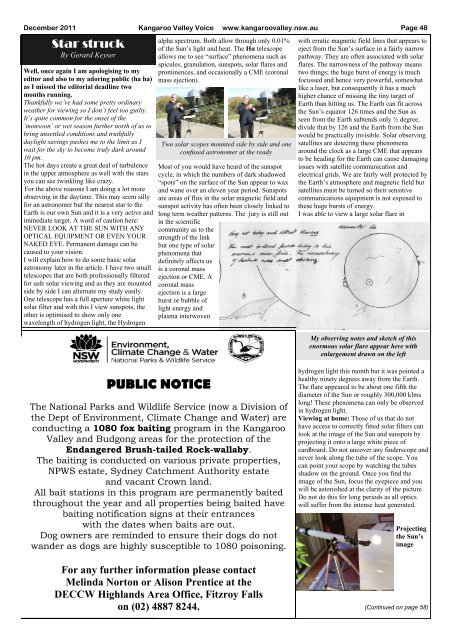Copy of december 2011.pub - Lazyfish Technology
Copy of december 2011.pub - Lazyfish Technology
Copy of december 2011.pub - Lazyfish Technology
Create successful ePaper yourself
Turn your PDF publications into a flip-book with our unique Google optimized e-Paper software.
December 2011 Kangaroo Valley Voice www.kangaroovalley.nsw.au Page 48<br />
Star struck<br />
By Gerard Keyser<br />
Well, once again I am apologising to my<br />
editor and also to my adoring public (ha ha)<br />
as I missed the editorial deadline two<br />
months running.<br />
Thankfully we’ve had some pretty ordinary<br />
weather for viewing so I don’t feel too guilty.<br />
It’s quite common for the onset <strong>of</strong> the<br />
‘monsoon’ or wet season further north <strong>of</strong> us to<br />
bring unsettled conditions and truthfully<br />
daylight savings pushes me to the limit as I<br />
wait for the sky to become truly dark around<br />
10 pm.<br />
The hot days create a great deal <strong>of</strong> turbulence<br />
in the upper atmosphere as well with the stars<br />
you can see twinkling like crazy.<br />
For the above reasons I am doing a lot more<br />
observing in the daytime. This may seem silly<br />
for an astronomer but the nearest star to the<br />
Earth is our own Sun and it is a very active and<br />
immediate target. A word <strong>of</strong> caution here:<br />
NEVER LOOK AT THE SUN WITH ANY<br />
OPTICAL EQUIPMENT OR EVEN YOUR<br />
NAKED EYE. Permanent damage can be<br />
caused to your vision.<br />
I will explain how to do some basic solar<br />
astronomy later in the article. I have two small<br />
telescopes that are both pr<strong>of</strong>essionally filtered<br />
for safe solar viewing and as they are mounted<br />
side by side I can alternate my study easily.<br />
One telescope has a full aperture white light<br />
solar filter and with this I view sunspots, the<br />
other is optimised to show only one<br />
wavelength <strong>of</strong> hydrogen light, the Hydrogen<br />
alpha spectrum. Both allow through only 0.01%<br />
<strong>of</strong> the Sun’s light and heat. The Hα telescope<br />
allows me to see “surface” phenomena such as<br />
spicules, granulation, sunspots, solar flares and<br />
prominences, and occasionally a CME (coronal<br />
mass ejection).<br />
Two solar scopes mounted side by side and one<br />
confused astronomer at the ready<br />
Most <strong>of</strong> you would have heard <strong>of</strong> the sunspot<br />
cycle, in which the numbers <strong>of</strong> dark shadowed<br />
“spots” on the surface <strong>of</strong> the Sun appear to wax<br />
and wane over an eleven year period. Sunspots<br />
are areas <strong>of</strong> flux in the solar magnetic field and<br />
sunspot activity has <strong>of</strong>ten been closely linked to<br />
long term weather patterns. The jury is still out<br />
in the scientific<br />
community as to the<br />
strength <strong>of</strong> the link<br />
but one type <strong>of</strong> solar<br />
phenomena that<br />
definitely affects us<br />
is a coronal mass<br />
ejection or CME. A<br />
coronal mass<br />
ejection is a large<br />
burst or bubble <strong>of</strong><br />
light energy and<br />
plasma interwoven<br />
with erratic magnetic field lines that appears to<br />
eject from the Sun’s surface in a fairly narrow<br />
pathway. They are <strong>of</strong>ten associated with solar<br />
flares. The narrowness <strong>of</strong> the pathway means<br />
two things; the huge burst <strong>of</strong> energy is much<br />
focussed and hence very powerful, somewhat<br />
like a laser, but consequently it has a much<br />
higher chance <strong>of</strong> missing the tiny target <strong>of</strong><br />
Earth than hitting us. The Earth can fit across<br />
the Sun’s equator 126 times and the Sun as<br />
seen from the Earth subtends only ½ degree,<br />
divide that by 126 and the Earth from the Sun<br />
would be practically invisible. Solar observing<br />
satellites are detecting these phenomena<br />
around the clock as a large CME that appears<br />
to be heading for the Earth can cause damaging<br />
issues with satellite communication and<br />
electrical grids. We are fairly well protected by<br />
the Earth’s atmosphere and magnetic field but<br />
satellites must be turned so their sensitive<br />
communications equipment is not exposed to<br />
these huge bursts <strong>of</strong> energy.<br />
I was able to view a large solar flare in<br />
My observing notes and sketch <strong>of</strong> this<br />
enormous solar flare appear here with<br />
enlargement drawn on the left<br />
PUBLIC NOTICE<br />
The National Parks and Wildlife Service (now a Division <strong>of</strong><br />
the Dept <strong>of</strong> Environment, Climate Change and Water) are<br />
conducting a 1080 fox baiting program in the Kangaroo<br />
Valley and Budgong areas for the protection <strong>of</strong> the<br />
Endangered Brush-tailed Rock-wallaby.<br />
The baiting is conducted on various private properties,<br />
NPWS estate, Sydney Catchment Authority estate<br />
and vacant Crown land.<br />
All bait stations in this program are permanently baited<br />
throughout the year and all properties being baited have<br />
baiting notification signs at their entrances<br />
with the dates when baits are out.<br />
Dog owners are reminded to ensure their dogs do not<br />
wander as dogs are highly susceptible to 1080 poisoning.<br />
For any further information please contact<br />
Melinda Norton or Alison Prentice at the<br />
DECCW Highlands Area Office, Fitzroy Falls<br />
on (02) 4887 8244.<br />
hydrogen light this month but it was pointed a<br />
healthy ninety degrees away from the Earth.<br />
The flare appeared to be about one fifth the<br />
diameter <strong>of</strong> the Sun or roughly 300,000 klms<br />
long! These phenomena can only be observed<br />
in hydrogen light.<br />
Viewing at home: Those <strong>of</strong> us that do not<br />
have access to correctly fitted solar filters can<br />
look at the image <strong>of</strong> the Sun and sunspots by<br />
projecting it onto a large white piece <strong>of</strong><br />
cardboard. Do not uncover any finderscope and<br />
never look along the tube <strong>of</strong> the scope. You<br />
can point your scope by watching the tubes<br />
shadow on the ground. Once you find the<br />
image <strong>of</strong> the Sun, focus the eyepiece and you<br />
will be astonished at the clarity <strong>of</strong> the picture.<br />
Do not do this for long periods as all optics<br />
will suffer from the intense heat generated.<br />
Projecting<br />
the Sun’s<br />
image<br />
(Continued on page 58)

















